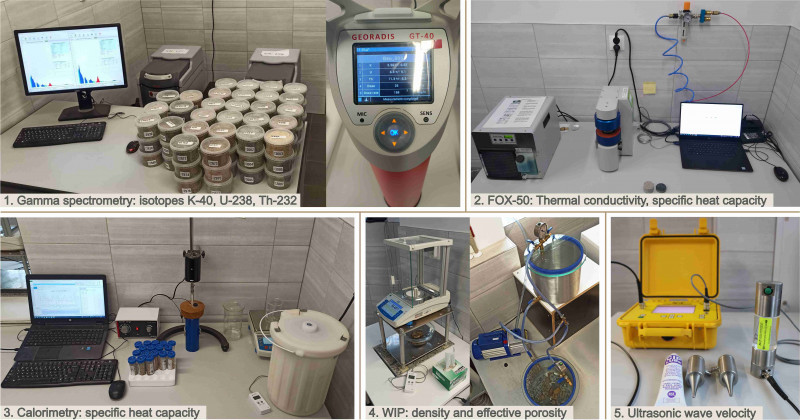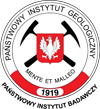The laboratory started its operations at the Lower Silesian Branch of the PGI-NRI in 2021, with the aim of addressing topics related to geothermal energy. Its primary objective is continuous development in the field of broadly understood petrophysical measurements. This includes enhancing existing research methods and developing new measuring stands. Equally important is the practical utilization of research results, such as integrating them with measurements from well logging.
Petrophysical Laboratory offer of analyses for rock samples

| No. | Analysis | Aparature | Requirements for sample | Norms and literature references |
| 1. |
Content of natural isotopes K-40, U-238, Th-232 |
Two gamma spectrometers equipped with BGO scintillation detectors of sizes 3x3 inches and relative efficiency of approximately 280%. The detectors are housed in low-background lead shields with a wall thickness of 10 cm. |
The sample must consists of crushed rock material with a particle size fraction < 5 mm and a volume > 570 cm³. | |
| 2. | Thermal conductivity, specific heat capacity, and thermal diffusivity in the temperature range 0-180°C | FOX-50 190, steady state heat flow meter |
Measurement of single thickness (1dx): A disk with a diameter ranging from 38 to 60 mm and a height between 8 and 26 mm. The two opposing surfaces of the disk must be parallel (allowable deviation from is 2 degrees). Surface finish using 600-grit grinding powder. For double thickness measurement (2dx), two disks with significant height differences (e.g., 10 mm and 25 mm) are required. |
ASTM C518 ISO 8301 DIN EN 12667 |
| 3. |
Specific heat capacity |
Calorimeter, mechanical stirrer, precise temperature recorders. |
Sample: rock fragments with particle sizes ranging from 3 to 9 mm. |
Schärli, U., & Rybach, L., 2001, Determination of specific heat capacity on rock fragments. Geothermics, 30(1), 93-110. |
| 4. |
Density and effective porosity using water immersion porosimetry |
Vacuum system for saturating rock samples and an analytical balance with sample suspension capability. |
Sample mass: ideally up to 170 g and with regular shapes (cube, cylinder, disk, etc.). The sample is saturated with water, so it should not contain minerals that swell or dissolve in water.
|
Kuila, U., McCarty, D. K., Derkowski, A., Fischer, T. B., & Prasad, M. , 2014, Total porosity measurement in gas shales by the water immersion porosimetry (WIP) method. Fuel, 117, 1115-1129. |
| 5. |
Ultrasonic wave velocity |
V-METER MK IV with ultrasonic transducers of 54 kHz |
Sample with minimum two parallel faces and a minimum side length of 80 mm. |
ASTM C-597 BS EN 12504 - 4:2004 ASTM D2845 - 08 ASTM E494 - 10 |
Petrophysical Laboratory is eqiupped with devices for rock preparation:
- Diamond saw
- Drilling machine
- Grinder-polisher
- Jaw crusher
- Plate mill
- Granulometry set
Contact:
Petrophysical Laboratory
Lower Silesian Branch
Polish Geological Institute – National Research Institute
19, Jaworowa Av.
53-122 Wrocław
Poland
Łukasz Jasiński
This email address is being protected from spambots. You need JavaScript enabled to view it.
tel. +48 71 337 20 92 wew. 165
Piotr Słomski
This email address is being protected from spambots. You need JavaScript enabled to view it.
tel. +48 71 337 20 92 wew. 166


